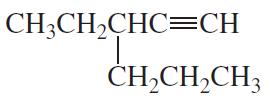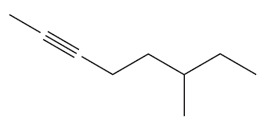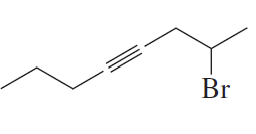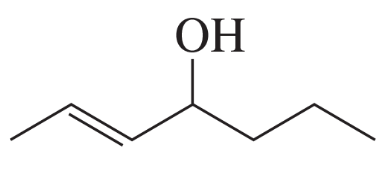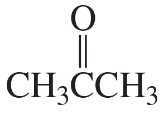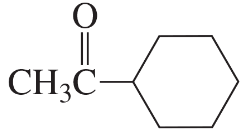 Back
Back Bruice 8th Edition
Bruice 8th Edition Ch.7 - The Reactions of Alkynes An Introduction to Multistep Synthesis
Ch.7 - The Reactions of Alkynes An Introduction to Multistep SynthesisProblem 1a,b
Name the following:
a.
b.
Problem 1c
Name the following:
c.
Problem 1d
Name the following:
d.
Problem 2a
Name the following:
a.
Problem 2c
Name the following:
c.
Problem 3a
What is the molecular formula for a monocyclic hydrocarbon with 14 carbons and 2 triple bonds?
Problem 4a
Draw the condensed and skeletal structures for each of the following:
a. 1-chloro-3-hexyne
Problem 4b
Draw the condensed and skeletal structures for each of the following:
b. cyclooctyne
Problem 4c
Draw the condensed and skeletal structures for each of the following:
c. isopropylacetylene
Problem 4d
Draw the condensed and skeletal structures for each of the following:
d. sec-butylisobutylacetylene
Problem 4e
Draw the condensed and skeletal structures for each of the following:
e. 4,4-dimethyl-1-pentyne
Problem 4f
Draw the condensed and skeletal structures for each of the following:
f. dimethylacetylene
Problem 5a
Draw the structures and give the common and systematic names for the seven alkynes with molecular formula C6H10.
Problem 7a
Name the following:
a.
Problem 7b
Name the following:
b.
Problem 8a,b,c
What orbitals are used to form the carbon–carbon s bond between the highlighted carbons?
a.
b.
c.
Problem 8g,h,i
What orbitals are used to form the carbon–carbon s bond between the highlighted carbons?
g.
h.
i.
Problem 9a
In Table 7.2, what is the smallest alkane, the smallest terminal alkene, and the smallest terminal alkyne that are liquids at room temperature, which is generally taken to be 20 °C to 25 °C?
Problem 10
Why does cis-2-butene have a higher boiling point than trans-2-butene?
Problem 13a
Drawing on what you know about the stereochemistry of alkene addition reactions,
a. write the mechanism for the reaction of 2-butyne with one equivalent of Br2.
Problem 13b
Drawing on what you know about the stereochemistry of alkene addition reactions,
b. predict the configuration of the product of the reaction.
Problem 14
What ketones are formed from the acid-catalyzed hydration of 3-heptyne?
Problem 15a,b
Which alkyne should be used for the synthesis of each of the following ketones?
a.
b.
Problem 15c
Which alkyne should be used for the synthesis of each of the following ketones?
c.
Problem 17a
For each of the following alkynes, draw the products obtained from (1) the acid-catalyzed addition of water (mercuric ion is added for part a) and from (2) hydroboration–oxidation:
a. 1-butyne
Problem 18
Only one alkyne forms an aldehyde when it undergoes the mercuric-ion-catalyzed addition of water. Identify the alkyne.
Problem 19a
Describe the alkyne you should start with and the reagents you should use if you want to synthesize
a. pentane.
Problem 19b
Describe the alkyne you should start with and the reagents you should use if you want to synthesize
b. cis-2-butene.
Problem 19c,d
Describe the alkyne you should start with and the reagents you should use if you want to synthesize
c. trans-2-pentene.
d. 1-hexene.



